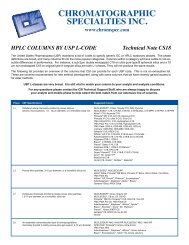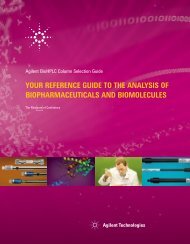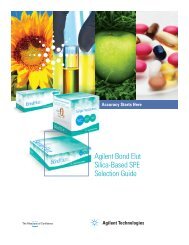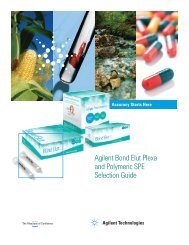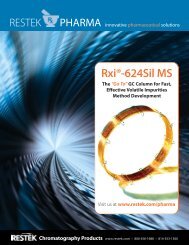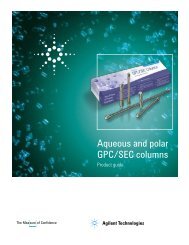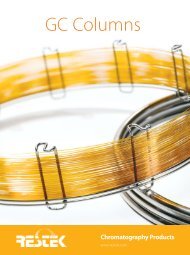Optimizing the Analysis of Volatile Organic Compounds
Optimizing the Analysis of Volatile Organic Compounds
Optimizing the Analysis of Volatile Organic Compounds
You also want an ePaper? Increase the reach of your titles
YUMPU automatically turns print PDFs into web optimized ePapers that Google loves.
36<br />
Leak Detective II<br />
Leak Detector<br />
Affordable <strong>the</strong>rmal conductivity leak<br />
detector—every analyst should have one*<br />
Compact, ergonomic design is easy to<br />
hold and operate with one hand.<br />
Helium, hydrogen, and nitrogen can be<br />
detected at 1x10 -4 cc/sec. or at an absolute<br />
concentration as low as 100ppm**<br />
Fast results—responds in less than 2 seconds<br />
to trace leaks <strong>of</strong> gases with <strong>the</strong>rmal<br />
conductivities different than air.<br />
Micro-chip design improves sensitivity<br />
and response time over previous models.<br />
Auto zeroing with <strong>the</strong> touch <strong>of</strong> a button.<br />
Battery-operated for increased portability<br />
(one 9-volt).<br />
Description qty. cat.#<br />
Leak Detective II Leak Detector ea. 20413<br />
* Never use liquid leak detectors on a capillary<br />
system. Liquids can be drawn into <strong>the</strong><br />
system.<br />
** Caution: NOT designed for determining<br />
leaks <strong>of</strong> combustible gases. A combustible<br />
gas detector should be used for determining<br />
combustible gas leaks in possibly hazardous<br />
conditions.<br />
www.restekcorp.com<br />
MS Contamination<br />
A universal detector, <strong>the</strong> MS responds to all organic compounds and, consequently, any contamination<br />
potentially can interfere with target analyte identification. The common sources<br />
<strong>of</strong> contamination are column bleed and septum bleed. High column bleed can be an indication<br />
<strong>of</strong> oxygen entering <strong>the</strong> system and degrading <strong>the</strong> stationary phase in <strong>the</strong> column. If high<br />
column bleed is suspected, conduct a leak check <strong>of</strong> <strong>the</strong> system, using <strong>the</strong> procedure<br />
described on page 34 and 35. Septum bleed introduces silicon fragments, characterized by<br />
ion 73, into <strong>the</strong> system. Silicon compounds also are components <strong>of</strong> GC and MS seals. Table<br />
VI lists common contaminants and <strong>the</strong> ions by which <strong>the</strong>y can be identified.<br />
Water / Methanol: The introduction <strong>of</strong> water and/or methanol vapor from <strong>the</strong> purge and trap<br />
system can cause problems in an MS system. Excess water vapor entering <strong>the</strong> MS can<br />
decrease <strong>the</strong> ionization <strong>of</strong> target analytes eluting at <strong>the</strong> same time. To overcome problems<br />
associated with water vapor, use a trap containing hydrophobic adsorbents, such as <strong>the</strong><br />
Vocarb ® 3000 trap. If you are using an ion trap system, increase <strong>the</strong> split ratio in <strong>the</strong> injection<br />
port. This will prevent overloading <strong>the</strong> ion trap and will increase overall linearity for <strong>the</strong><br />
gaseous analytes.<br />
Table VI.<br />
Common contaminants and <strong>the</strong>ir identifying ions.<br />
Contaminant Characteristic Fragmentation Ions<br />
Silicon 73, 147, 207, 221, 281, 355, 429, 503<br />
Rough vacuum pump oil 55-57, 61-67, 81-85, 95-99<br />
Diffusion pump oil 77, 115, 141, 168, 223, 260, 446<br />
Plasticizers 149, 223, 278<br />
Practical Introduction to GC/MS <strong>Analysis</strong> with Quadrupoles<br />
The text gives answers to questions such as: how does <strong>the</strong> mass<br />
spectrometer work, what problems can occur and how do I detect<br />
<strong>the</strong>m, how must separation and detection be adapted to each o<strong>the</strong>r,<br />
and what pitfalls can be avoided when elucidating structures and<br />
quantifying compounds.<br />
M. Oehme, Wiley-VCH<br />
1999, 195pp., ISBN 3-527-29748-0<br />
cat.# 21098<br />
Interpretation <strong>of</strong> Mass Spectra, 4 th Edition<br />
This updated version builds on <strong>the</strong> strengths <strong>of</strong> <strong>the</strong> previous editions<br />
and presents <strong>the</strong> information required to clearly and concisely interpret<br />
mass spectra. Chapters include information on elemental composition,<br />
molecular ions, mechanisms <strong>of</strong> ion fragmentations, unimolecular<br />
ion decompositions, and mass spectra <strong>of</strong> common compound<br />
classes. It is valuable and necessary resource for every person practicing<br />
mass spectrometry.<br />
F.W. McLafferty and F. Turecek, University Science<br />
1993, 371pp., ISBN 0-935702-25-3<br />
cat.# 20498





